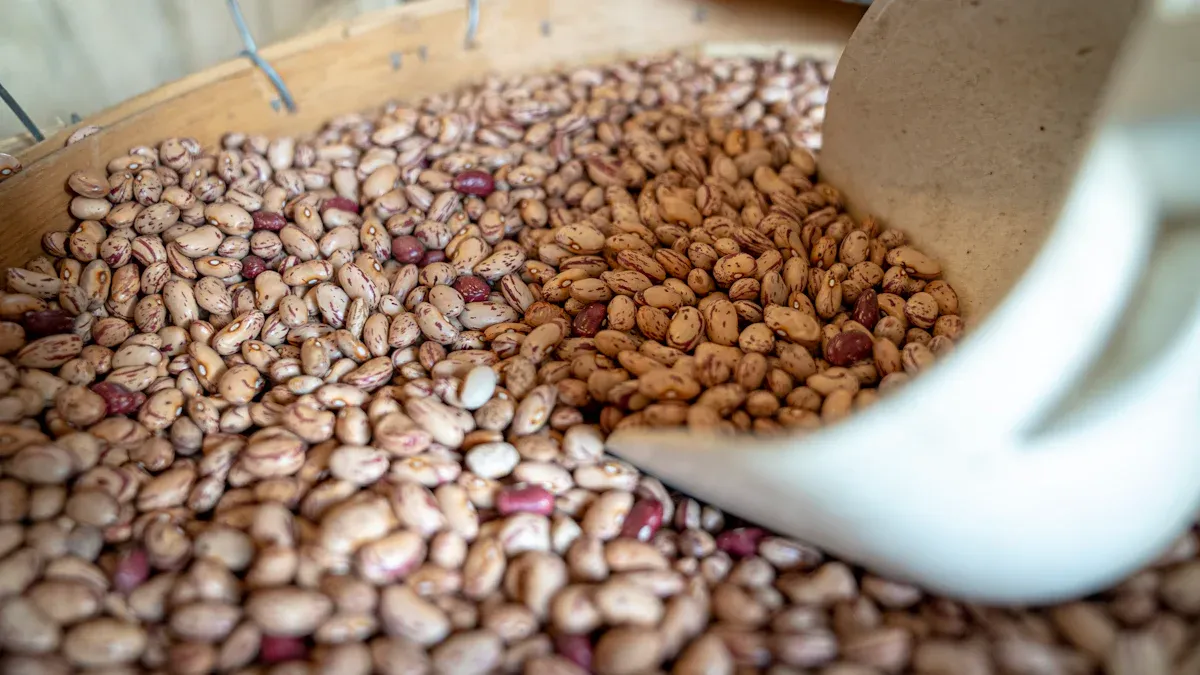
Pinto beans give you a strong boost of plant-based protein and fiber, making them a smart choice for a healthy diet. You get 15 grams of protein and 15 grams of fiber in each cup, which supports your health and helps you feel full. Pinto beans nutrition stands out with high levels of folate, copper, and thiamine. The table below compares pinto beans to other popular beans:
Nutrient | Pinto Beans (1 cup) | Black Beans (1 cup) | Navy Beans (1 cup) |
|---|---|---|---|
Calories | 245 | 227 | 255 |
Protein (g) | 15.4 | 15 | 15.8 |
Fat (g) | 1.11 | 0.9 | 0.9 |
Carbohydrates (g) | 44.8 | 40.4 | 47.4 |
Fiber (g) | 15.4 | 15 | 13.1 |
Thiamine (B1) %DV | 28% | 24% | 20% |
Folate (B9) %DV | 74% | 64% | 60% |
Copper %DV | 42% | 30% | 30% |
Manganese %DV | 34% | 30% | 30% |
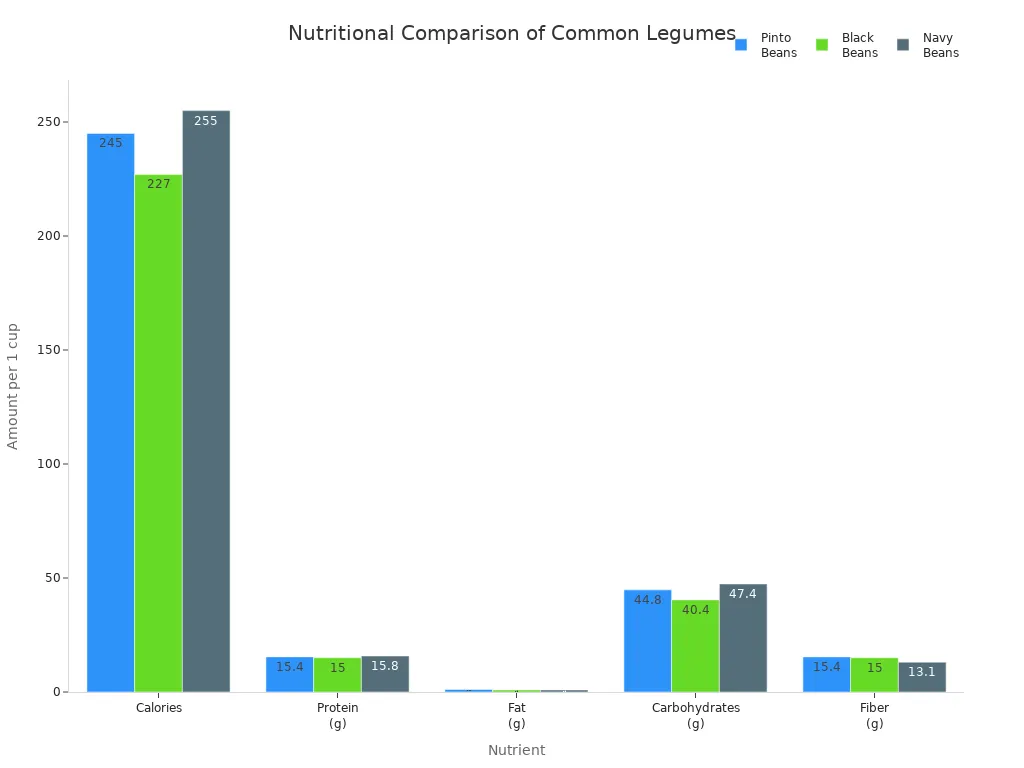
You can enjoy the nutrition benefits of pinto beans in many recipes and support your wellness with every meal.
Key Takeaways
Pinto beans are a powerhouse of nutrition, offering 15 grams of protein and 15 grams of fiber per cup, which helps you feel full and supports muscle growth.
Rich in essential vitamins and minerals, pinto beans provide significant amounts of folate, iron, and potassium, promoting overall health and wellness.
Including pinto beans in your diet can support heart health by lowering cholesterol levels and reducing the risk of coronary heart disease.
Pinto beans help manage blood sugar levels due to their low glycemic index, making them a smart choice for those with diabetes.
Regular consumption of pinto beans can aid in weight management by keeping you satisfied longer, thanks to their high fiber and protein content.
Pinto Beans Nutrition
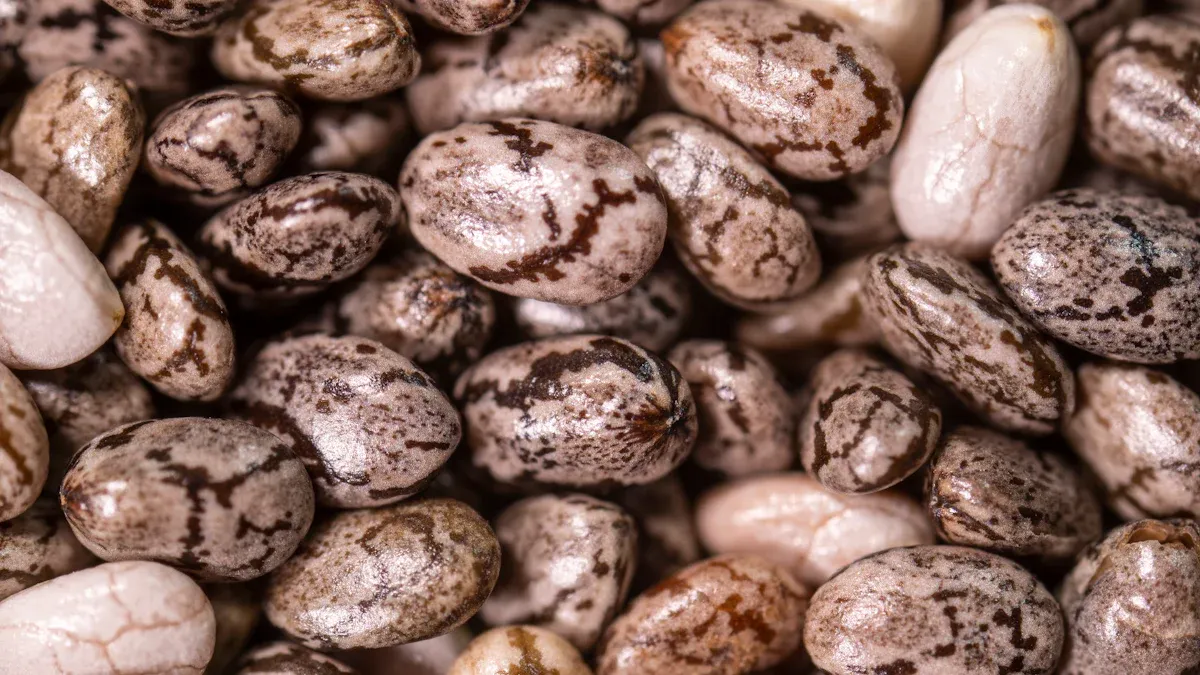
Protein and Fiber
You get a powerful boost of plant-based protein when you eat pinto beans. Each serving gives you about 15.4 grams of protein, making pinto beans an excellent source of protein for your meals. If you want to follow a plant-based diet, pinto beans nutrition helps you meet your daily protein needs. Pinto beans are packed with plant-based protein, which supports muscle growth and keeps you feeling full.
Pinto beans contain about 21.47 grams of protein per 100 grams.
One serving of cooked pinto beans provides 15.4 grams of protein.
Fiber is another key part of pinto beans nutrition. You get a good source of fiber in every serving, which helps your digestion and keeps your gut healthy. Pinto beans are high in fiber, so they fit well into a high-fiber diet. The table below shows how the fiber content in pinto beans compares to other beans:
Bean Type | Fiber Content (grams per ½ cup) |
|---|---|
Black Beans | 8 |
Pinto Beans | 6 |
If you want to increase your dietary fiber intake, pinto beans are a smart choice. You get 7.7 grams of fiber in just half a cup. This makes pinto beans a good source of fiber for your daily meals.
Vitamins and Minerals
Pinto beans nutrition gives you many important vitamins and minerals. You get high potassium, magnesium, iron, and folate in every serving. These nutrients help your body work well and support your health. The table below shows the amounts of vitamins and minerals you get from pinto beans:
Vitamin/Mineral | Amount per Serving | Daily Value (%) |
|---|---|---|
Calcium | 138mg | 14% |
Iron | 6.3mg | 78% |
Magnesium | 150mg | 36% |
Phosphorus | 441mg | 63% |
Potassium | 1308mg | 38% |
Sodium | 3mg | 0.13% |
Zinc | 2.9mg | 27% |
Copper | 0.66mg | 73% |
Manganese | 1.4mg | 59% |
Selenium | 19µg | 34% |
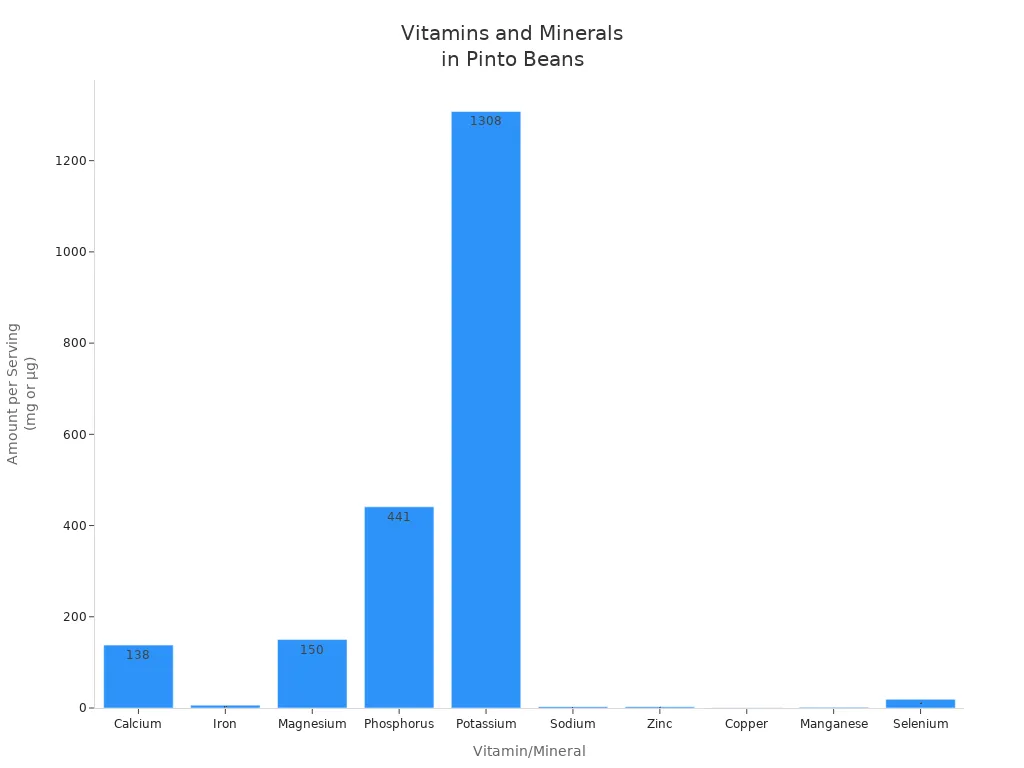
You get thiamine, iron, magnesium, potassium, and phosphorus from pinto beans. Folate is another important nutrient in pinto beans nutrition. Folate helps your body make blood cells and supports DNA formation. Folate is crucial during pregnancy for fetal development. It also supports cardiovascular health and may protect against certain cancers. Pinto beans are rich in antioxidants, which help protect your cells from damage.
If you want to meet your daily needs for potassium and folate, pinto beans are a great choice. One serving gives you 12% of your daily potassium and 51% of your daily folate. These nutrition benefits make pinto beans a smart addition to your meals.
Excellent Source of Fiber
Pinto beans are an excellent source of fiber. You get 7.7 grams of fiber in just half a cup, which helps you reach your recommended daily intake. The table below shows how much fiber you get from pinto beans:
Food Item | Serving Size | Fiber Content |
|---|---|---|
Pinto beans | 1/2 cup | 7.7 grams |
You need fiber for healthy digestion and regular bowel movements. Pinto beans nutrition supports a high-fiber diet and helps you feel full longer. If you want to manage your weight or improve your gut health, pinto beans are a good source of fiber.
Tip: Pinto beans are naturally free of gluten and cholesterol. You can enjoy them if you follow a gluten-free or cholesterol-free diet. Pinto beans are rich in protein, fiber, and folate. You also get essential nutrients like iron, magnesium, thiamin, calcium, and zinc.
Pinto beans nutrition gives you many nutritional benefits. You get plant-based protein, fiber, vitamins, and minerals in every serving. Pinto beans fit many diets and help you reach your health goals.
Pinto Bean Health Benefits
Heart Health
You can support your heart health by adding pinto beans to your meals. Pinto beans contain plant-based protein, fiber, and polyunsaturated fatty acids that help lower cholesterol and protect your heart. Studies show that eating half a cup of pinto beans daily for eight weeks can reduce total cholesterol and LDL cholesterol. You may see a decrease in your risk for coronary heart disease.
Aspect | Details |
|---|---|
Objective | To determine effects of daily intake of 1/2 cup pinto beans on risk factors for coronary heart disease (CHD) and diabetes mellitus (DM) in mildly insulin resistant adults over an 8 week period. |
Methods | Randomized, crossover design with sixteen participants receiving each treatment for eight weeks. Fasting blood samples were analyzed for total cholesterol (TC) and low-density lipoprotein cholesterol (LDL-C). |
Results | Significant reductions in serum TC (p = 0.026) and LDL-C (p = 0.033) after eight weeks of pinto bean consumption. Mean change of serum TC for pinto beans was −19 ± 5 mg/dL (p = 0.011) and for LDL-C was −14 ± 4 mg/dL (p = 0.013). |
Conclusions | Pinto bean intake should be encouraged to lower serum TC and LDL-C, thereby reducing risk for CHD. |
You can also benefit from lower non-HDL cholesterol when you eat whole pinto beans or their hulls. Substituting animal protein with pulses like pinto beans increases fiber and decreases cholesterol by more than 10%. Pinto beans nutrition supports heart health by providing omega-3 fatty acids such as alpha-linolenic acid, which your body converts to EPA and DHA. These compounds help protect your heart and reduce inflammation.
Blood Sugar Support
You can manage your blood sugar levels by including pinto beans in your diet. Pinto beans have a low glycemic index of 39, which means they do not cause sharp spikes in blood sugar. A half-cup serving contains 22 grams of carbohydrates and a glycemic load of about 9. Low-GI foods like pinto beans are helpful for people with diabetes.
Pinto beans help stabilize blood sugar levels.
You can reduce the glycemic response of high-GI foods, such as rice, by eating pinto beans with them.
Regular consumption of beans may reduce post-meal blood sugar swings and improve vascular health.
Study Type | Findings |
|---|---|
Randomized, crossover, placebo-controlled | Pinto beans do not significantly lower glycemic response when consumed with high-GI foods. |
You may find that pinto beans nutrition helps you control diabetes and maintain steady blood sugar levels. The fiber in pinto beans slows down digestion and absorption of carbohydrates, which supports healthy blood sugar management.
Gut and Digestive Health
You can improve gut health by eating pinto beans regularly. Pinto beans are rich in fiber, which feeds beneficial bacteria in your colon. This process produces short-chain fatty acids that support gut integrity and reduce inflammation.
Study Title | Findings |
|---|---|
Pinto Beans Supplementation Impacted the Gut Microbiome, Inflammation, MHC II Expression and Glucose Homeostasis in C57BL/6 J Mice | This study evaluated the protective effects of pinto bean supplementation on gut microflora and inflammation, indicating a positive impact on gut health. |
Pinto Bean Supplementation Modulates Gut Microbiota and Improves Markers of Gut Integrity in a Mouse Model of Estrogen Deficiency | PB supplementation improves gut microbial diversity and integrity, suggesting benefits for gut health in estrogen deficiency. |
Effects of processed oats and pinto beans on the composition of human gut microbiome: An in vitro study | Pinto beans produced more beneficial short-chain fatty acids (SCFA) than oats, indicating their positive effect on gut microbiota. |
Note: The non-digestible fibers in pinto beans act as prebiotics. They stimulate the growth of healthy microflora and help maintain digestive regularity. You may notice some gas at first, but this usually decreases after a few weeks as your gut adapts. Regular bean consumption can also improve mineral absorption and boost your immunity.
Weight Management
You can promote weight loss and manage your weight by eating pinto beans. Pinto beans help you feel full longer because they are high in fiber and protein. Observational studies show that people who eat beans tend to have lower body weights and smaller waist sizes.
A randomized controlled trial found that meals with whole pinto beans or bean flour reduced hunger and food intake compared to control meals. You may find it easier to control your appetite and reduce calorie intake when you include pinto beans in your diet.
Evidence Type | Findings |
|---|---|
Nutrient Intake | Adults consuming beans had higher intake of essential nutrients, including those often under-consumed. |
Weight Outcomes | Bean consumers showed lower body mass index (BMI) and waist circumference. |
Dietary Guidelines | Bean consumption aligns better with USDA’s Healthy Eating Index, indicating improved diet quality. |
Tip: Pinto beans nutrition supports weight management and helps you reach your health goals. You can add pinto beans to salads, soups, or grain bowls for extra satiety.
Disease Prevention
You can lower your risk for chronic diseases such as diabetes and cancer by eating pinto beans. Pinto beans have a low glycemic index and high fiber content, which help control blood sugar and support digestive health. Increased bean consumption is linked to a 23% decreased risk of diabetes and a 6% reduced risk for cancer.
Evidence Type | Description |
|---|---|
Low Glycemic Index | Pinto beans have a low GI, promoting better blood sugar management. |
High Fiber Content | Their high fiber content aids in blood sugar control and overall digestive health. |
Antioxidant Properties | Pinto beans are rich in antioxidants like kaempferol, which may offer anticancer benefits. |
Pinto beans contain polyunsaturated fatty acids, including omega-3s, that support cardiovascular health. You also get polyphenolic compounds that protect against oxidative stress and may reduce the risk of colon tumors. Pinto bean health benefits include anti-inflammatory and anti-proliferative effects, which help protect you from chronic diseases.
Callout: You can enjoy the health benefits of pinto beans by making them a regular part of your meals. Pinto beans nutrition provides plant-based protein, fiber, and antioxidants that support your overall health.
Drawbacks and Tips
Digestive Concerns
You may notice some digestive changes when you eat pinto beans. The most common concerns include increased flatulence, stool changes, and bloating. These effects happen because pinto beans contain oligosaccharides, which your gut bacteria break down and produce gas. The table below shows how often these symptoms appear:
Concern | Prevalence (%) | Week 1 | Week 2 | Week 3 | Weeks 6-12 |
|---|---|---|---|---|---|
Increased flatulence | 45% | 45% | 38% | 30% | 15-23% |
Stool changes | 8-20% | 8-20% | 8-20% | 8-20% | 1-2% |
Bloating | 25% | 25% | 40% | 3-5% | 3-5% |
Control group flatulence | 3-8% | 3-8% | 3-8% | 3-8% | 3-8% |
You may find that these symptoms decrease over time as your body adapts. Soaking beans for at least 16 hours and discarding the soak water can help reduce gas. Adding herbs like peppermint, ginger, or cumin may also aid digestion.
Allergies
Pinto bean allergies are rare, but you should know what symptoms to watch for. Most reported cases involve immediate reactions, such as hives, itching, or vomiting. Severe cases can lead to anaphylaxis, which is life-threatening. The table below summarizes allergy facts:
Evidence Type | Description |
|---|---|
Allergy Rarity | Pinto bean allergies are considered rare, with only three reported cases. |
Common Symptoms | Hives, itching, vomiting, and in severe cases, anaphylaxis. |
IgE-mediated Reactions | Immediate reactions are typical, while delayed symptoms may also occur. |
Mild symptoms: itching, hives, vomiting
Severe symptoms: anaphylaxis, which affects breathing and circulation
If you have a history of legume allergies, you should consult a doctor before adding pinto beans to your diet.
Preparation Advice
You can make pinto beans easier to digest by following a few simple steps. Start by soaking beans in very warm, alkaline water and change the water often. This process helps break down oligosaccharides and remove anti-nutrients. Cook beans long and slow for better digestibility. Use stock instead of water for cooking to improve flavor and digestion. Serving beans with fermented foods can also help.
Here is a step-by-step guide for preparing pinto beans:
Spread beans on a cookie sheet and remove debris.
Rinse beans under cold water.
Place beans in a large pot with 5 cups of water for every 1 cup of dried beans.
Bring to a boil and boil for 2 to 3 minutes.
Remove from heat and cover the pot.
For quick soak, let sit for at least an hour; for hot soak, up to 4 hours; for overnight soak, refrigerate for at least 8 hours.
Drain and rinse soaked beans.
Place beans in a pot with 3 cups of water for every 1 cup of dried beans.
Bring to a boil, then reduce heat and simmer until tender (1 to 2 hours).
Tip: Boiling pinto beans without broth gives the highest protein efficiency and digestibility. Cooking with broth increases tannin content, which may lower digestibility.
You can enjoy the plant-based benefits of pinto beans nutrition while supporting your health and getting more fiber by using these preparation tips.
Cooking with Pinto Beans
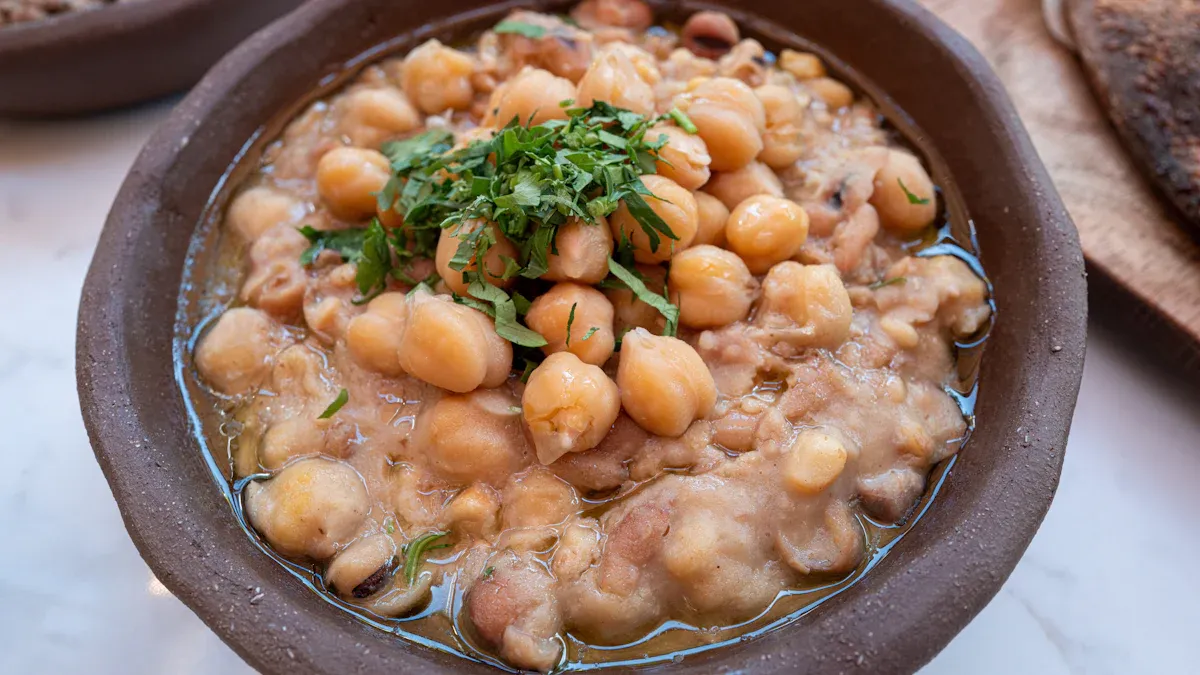
Preparation Methods
You can prepare pinto beans in several simple ways at home. Many people soak pinto beans overnight, then slow cook them with garlic, onions, spices, or jalapeño juice. Some cooks add pork for extra flavor. You might make a big pot on Sunday to enjoy leftovers during the week. If you want to save time, you can skip soaking—just sort and rinse the beans, then boil and simmer until tender. Another popular method involves soaking, rinsing, sautéing aromatics, and simmering with seasonings. Soaking pinto beans for eight hours or overnight helps hydrate them, shortens cooking time, and makes the texture smoother. Quick soaking works too, but you may lose some nutrients. Soaking also helps reduce carbohydrates that cause digestive issues, making the beans easier to digest.
Easy Meal Ideas
You have many delicious ways to enjoy pinto beans in your meals. Try Crock Pot Pinto Beans with sautéed onion, jalapeño, and southwestern spices for a plant-based dish. Pinto Bean Soup with vegetables and sausage works well in a slow cooker. Oven Baked Bean Burritos use refried pinto beans, rice, and cheese for a quick meal. Pinto Bean Casserole is vegetarian and gluten-free, ready in less than 30 minutes. You can make Pinto Bean & Cheese Freezer Burritos for busy days. Pinto Bean Salad with avocado and tomatoes tastes refreshing in warm weather. Spanish Pinto Bean Stew packs nutrients with vegetables. Healthy Turkey Chili with pinto beans offers a lighter option. Quick Pinto Beans & Rice makes a one-pot meal in 30 minutes.
Flavor Pairings
You can pair pinto beans with many ingredients to create balanced meals. In burritos, combine pinto beans with eggs or avocado for added nutrition. In chili, pinto beans work well with meats and spices. Soups with pinto beans taste great with vegetables and proteins like chicken or tofu. Salads with pinto beans provide a nutritious base for fresh produce. Pinto beans match the flavors of Texas Mexican cuisine and adapt to Greek recipes with garlic, oregano, and olive oil. You can enhance pinto beans with cheeses like Cheddar, Monterey Jack, or feta. These pairings boost both flavor and health benefits, making pinto beans nutrition a smart choice for your kitchen.
Tip: You can enjoy the fiber and plant-based benefits of pinto beans by adding them to your favorite dishes. Try new combinations to discover more delicious ways to enjoy pinto beans.
You discover many benefits when you choose pinto beans for your meals. Pinto beans nutrition supports heart health, helps regulate blood sugar, and may lower cancer risk. You enjoy plant-based protein and fiber, which keep you full and energized. Cooking with pinto beans is simple. Soak, rinse, and simmer for a tasty addition to soups, salads, or burritos. Try adding pinto beans to your weekly menu for better health and more variety.
FAQ
What makes pinto beans a healthy food choice?
You get plant-based protein, fiber, and many vitamins from pinto beans. These nutrients help your heart, support digestion, and keep you full. Pinto beans also have antioxidants that protect your cells.
What is the best way to cook pinto beans?
You can soak pinto beans overnight, then simmer them until tender. This method helps reduce cooking time and makes the beans easier to digest. You can also use a slow cooker for convenience.
What nutrients do you get from pinto beans?
You get protein, fiber, folate, iron, magnesium, and potassium from pinto beans. These nutrients support your muscles, blood, and overall health. Pinto beans are also low in fat and free of cholesterol.
What should you do if pinto beans cause gas?
You can soak beans before cooking and change the water to help reduce gas. Start with small servings and increase slowly. Your body will adjust over time, and symptoms usually decrease.
What dishes can you make with pinto beans?
You can add pinto beans to soups, salads, burritos, and casseroles. They taste great in chili or as a side dish. You can also mash them for dips or spreads.


